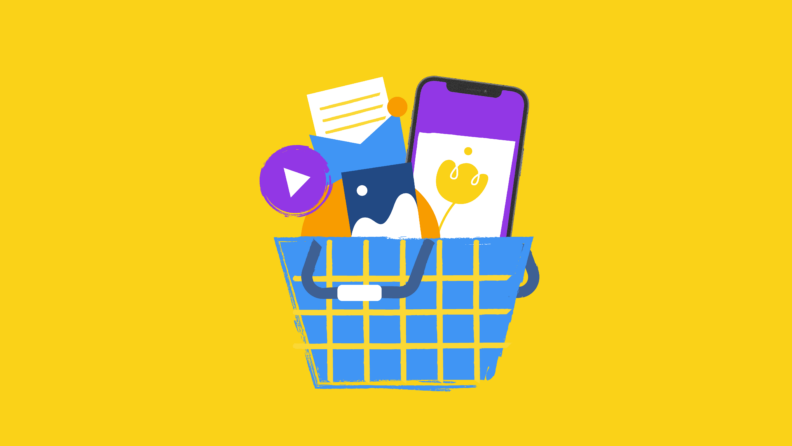Curious whose decision it was to purchase that billboard you drive by twice a week? Or ever wondered why that particular banner or display ad pops up on Amazon? You have media buying to thank for that! But what is media buying, exactly?
Media buying is an oft-overlooked marketing strategy that powers entire industries and is a large source of revenue for various brands in digital marketing spaces.
The media buying process is similar to the occult because it is often hidden in shadows and tosses around terms that no one else seems to use, like RFPs, IOs, DSPs, SSPs, and so much more. Yet, it’s a powerful topic that any brand invested in growth should come to know, understand, and use.
In this article, I will define what we mean when we refer to media buying, separate the differences between media planning and media buying, drive home why it’s important and how it works, and provide essential tips for the entire media buying process.
What Is Media Buying?
In short, media buying is a part of paid marketing efforts.
Whether you are looking at digital media buying or taking out full-page print ads, it all falls under the umbrella of a media buying strategy. While media buying can include traditional media advertising spaces, it typically implies defining where to set up an ad campaign within the digital marketing space.
Effective media buying requires focusing only on your target audience, campaign goals, and KPIs on the media channels that make the most sense for your ad spend budget. Since this can dip into media planning, let’s break down the difference between buying and planning.
What is the Difference Between Media Buying and Media Planning?
At its core, the difference between media buying and media planning is the order in which they happen. Even if you don’t have someone specifically set as a media planner, you will need to do some media planning before you dive into media buying.
Media planning
Media planning involves covering everything you need to create an effective advertising marketing strategy.
To have an effective media plan in place, you need to consider things like the demographics of your target audience, which social media channels they are on, which ad exchange platforms find the most success, and a variety of other audience metrics.
Then, the media planner synthesizes all of this data into a programmatic advertising plan to hand off to the media buyer.
Media buying
Media buying is about getting the right paid marketing in front of the right audience at the right time.
While the media planner decides where the target audience resides and what types of paid marketing make the most sense, those in media buying focus on ad spend, ad inventory, and meeting marketing goals. Based on market research, media buying focuses on creating an ad media mix to hit those marketing goals.
Sometimes those in media buying focus solely on digital marketing ad spaces, some focus on billboards, and others worry about real-time ad placements on TV shows, news networks, etc.
Why Is Media Buying Important?
Watching the ad placements during the Super Bowl is an event on its own. In fact, in years past, nearly 40% of people watched the Super Bowl specifically for the ads. In 2023, however, those numbers dropped to roughly 18%. Not because they were less interested in the ads but because 16% of people in the survey were most excited to simply be together for a party.
This is where media buying becomes important, and why we must discuss the question, “What is media buying?” The media planner might decide that ad placement in the Super Bowl is incredible for brand awareness, but the media buyer might decide that it’s not a great use of ad spend because of the data coming in.
Those involved in media buying have to make the best choices with the information given to them to find the highest ROI for paid marketing opportunities. This leads to conversations about programmatic media buying, utilizing media buying agencies, and connecting with various advertising agencies.
How Does Media Buying Work?
In media buying, you can typically choose to work with either: programmatic media buying, media buying agencies, or advertising agencies.
I’ll briefly discuss how these formats work and then go into the overall process in more depth.
- Programmatic media buying is the process of using tools and software to find the ad placement that fits your needs. Tools like Google Ad Manager and PubMatic fall under this format. It’s important to note that these are almost entirely used for digital marketing ads.
- Media buying agencies are companies that solely focus on media planning and buying to help brands maximize their ROI and minimize their costs for media buying. Companies like Kiosk and Media Matters Worldwide are premiere media buying agencies. While media buying agencies can do traditional and digital media, they primarily focus on digital.
- Advertising agencies are marketing companies that can apply a wide breadth of knowledge and data to your media buying efforts. Typically, advertising agencies will provide media planning and media buying and develop your media buying strategy based on what makes the most sense from their data. Popular agencies include WPP and Omnicom Group.
These are the three most common routes people take when it comes to media buying, but it is, by no means, the only path you can take.
Smaller organizations can use programmatic media buying via a DSP (demand-side platform) software that focuses on automation in the media buying process, for example.
No matter how you go about it, digital advertising and media buying go hand-in-hand. What matters is creating optimization in the media buying process so you can succeed more often than not.
7 Steps (And Tips) For The Media Buying Process
The media buying process can be a bit intimidating at first. Still, with bigger ad campaigns, you will want to work with some help from a media buying agency or advertising agency.
Even if you are doing it completely solo, the below framework will still be helpful if you work each step as if you were going to hand things off to a media buying agency.
A simple-yet-effective media buying process consists of 7 steps:
1. Create an ad budget
When determining your ad spend for online or offline media buying, you need to research what a typical ad in that particular market costs. Doing plenty of research on what makes sense for display ads on LinkedIn before starting the process will save a lot of trouble for the later steps.
Once you have an ad budget in place, you can begin to move into drafting an RFP document.
2. Send requests for proposals
Once you have your ad budget, you can draft a Request for Proposals (RFP) document. When doing this, make yourself a template for future RPFs so you can ensure your media buying process gets smoother with each campaign.
Your RFP document should clearly communicate what you are looking for and the expected range you are willing to spend on the ad placement. Remember that, even if you aren’t working with a media buying agency, you may still need to draft an RFP to have a clear idea of how the process will look with future projects.
3. Lock in an insertion order (IO) agreement
An insertion order (IO) is, essentially, the contract that means you have locked in work for a particular ad campaign with that particular media buying company.
Before locking in your IO, consider all possible companies based on factors such as previous successful projects, other businesses they have worked with, and overall compatibility with your brand. At all costs, you should protect your brand throughout the media buying process.
A poorly launched ad campaign can have powerful negative side effects on your brand.
4. Send out creatives to media outlets
As you finalize your ad creatives, send them ready to roll out for each media outlet. If you are working with a media buying agency or advertising agency, they may be able to handle this for you directly.
Make sure all of your ad creatives throughout the various media outlets you will launch tell a cohesive story. Ensure there are no contradictions or opposition between ads, even if they are totally different media.
5. Launch your campaign
As you launch your campaign, be prepared to start collecting data and have team members ready to analyze and assess what is working and what isn’t throughout the ad campaign.
6. Collect data and start optimization
When the data for your ad campaign starts rolling in from various media, be sure to track as much as possible. It might seem overkill to know which creatives went out at what time and to what platform, but every media outlet uses its own algorithms that might not be a perfect fit for your specific ad campaign. This could be useful information for future campaigns.
Don’t neglect to research various search engines to see where your ads are popping up, where, when, and how. Doing your research in conjunction with the research from your ad campaign partners can only improve future campaigns!
7. Reconcile ad spend with ad budget and renegotiate where necessary
The final stage of the media buying process is to sit down with all the numbers and start crunching them together. You need to start by determining exactly how much you budgeted versus how much you spent on your ad campaign.
Compare these numbers to your KPIs and determine if you were hitting the right marketing goals or what needs to be shifted and changed. Oftentimes, you can go back and renegotiate on ad campaigns that didn’t meet certain goals, especially if you were working with a media buying agency.
A key focus for this stage of the media buying process is to consider continuing relationships with all the agencies, companies, or media outlets you have worked with for your ad campaign. Even if things didn’t go as planned this time, continuing good networking relationships can encourage more growth for future ad campaigns.
“What Is Media Buying?” Answered For Your Brand
Now that you know what media buying is and how it works, I hope you can confidently move your brand forward in the media buying process for the best long-term success of your paid marketing campaigns.
If dealing with media outlets or buying agencies stresses you out, then make sure to subscribe to the Indie Media Club newsletter for more content on all things media-related to make you feel more confident and comfortable in the space.
If you’ve got any questions we can answer, or you just want to suggest an idea for further conversation on media buying, leave a comment and let us know.
More from IMC:
- The Essential Media Planning Guide For Digital Brands & Publishers
- The No-Nonsense Digital Audio Advertising Guide For Brands And Publishers
- Digital Video Advertising Guide: Your First Step To Building A Profitable Media Empire
- 7 Types Of Social Media Advertising To Improve Your Online Presence
- 10 Best Audio Advertising Software
- 10 Best Video Advertising Networks To Monetize Your Content
- 10 Best Social Media Advertising Software


